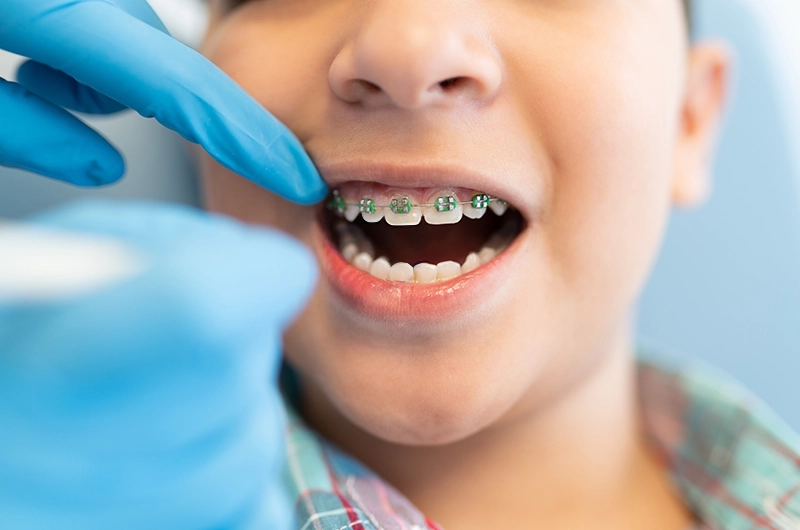Orthodontics for Children and Teenagers
Guiding your child’s smile to its full potential

Orthodontics for Children and Teenagers
Guiding your child’s smile to its full potential
When most people think of orthodontics, the first image that comes to mind is a teenager with a mouth full of metal braces. Maybe that teenager was you, sporting the classic “train tracks” that were once the norm.
But times have changed. Orthodontics is no longer just for teens, and in fact, treatment can begin much earlier. You don’t even need to wait until all your child’s baby teeth have erupted before speaking with a dentist about their developing bite.
Alma Dental Surgery’s caring team is passionate about preventive and minimally invasive treatment. In some cases, early orthodontic intervention in childhood can reduce—or even eliminate—the need for braces later on. It can also offer lifelong benefits beyond just straighter teeth, including:
- Shorter or less complex orthodontic treatment in the teenage years
- Improved sleep, focus, and overall health
- Healthier airways and more efficient breathing
- Positive impacts on confidence and facial development
Why consider orthodontic treatment for young children?
Early assessment and intervention can make a lasting difference in your child’s oral health, development, and overall well-being.
Identifying and treating developing malocclusions (bite and alignment issues) in younger children offers several benefits:
At Alma Dental Surgery, we believe early diagnosis is key. As part of our comprehensive approach, we assess your child’s airways and breathing patterns from a young age. If we detect signs of possible obstructions—such as enlarged adenoids or tonsils—we work closely with sleep physicians or ENT specialists to ensure your child gets the care they need.
- Straighter teeth are easier to clean, helping reduce the risk of decay and gum disease throughout life.
- Protruding front teeth are more vulnerable to injury, especially during sports or active play. Early treatment can help reduce this risk.
- Persistent oral habits, such as thumb sucking, can be gently corrected through early orthodontic guidance.
- Speech or chewing difficulties linked to bite issues may be improved with timely intervention.
- Breathing difficulties—often related to narrow airways or oral development—can sometimes be addressed through orthodontic treatment.
Why do kids’ teeth grow crooked?
There are several reasons why children develop crooked teeth or misaligned jaws. These include:
Genetics – Hereditary factors play a major role in jaw and tooth development, including jaw size and alignment, crowding, spacing, missing or extra (supernumerary) teeth, and how the upper and lower jaws relate to one another.
Oral habits – Prolonged thumb or finger sucking, lip sucking, tongue thrusting, and extended use of pacifiers (especially beyond age 2–3) can influence tooth and jaw alignment.
Premature loss of baby teeth – Early tooth loss can cause adjacent teeth to shift into the empty space, leading to crowding or misalignment of the incoming permanent teeth.

Dental disease – Untreated cavities or gum infections in baby teeth can lead to premature loss or damage to developing permanent teeth.
Abnormal breathing patterns – Chronic mouth breathing, often linked to enlarged adenoids or tonsils, can affect jaw growth and facial development.
Trauma or injury – Accidents that affect the teeth or jaw, especially during early development, can alter the position or eruption pattern of teeth.
Muscular imbalances – Issues with tongue posture, chewing muscles, or unbalanced head and neck musculature can contribute to altered jaw development or bite problems.
At what age should your child have an orthodontic assessment?
At Alma Dental Surgery, we begin monitoring your child’s dental and jaw development from their very first visit—often before their first birthday. Every check-up includes a gentle assessment of how their teeth and jaws are growing.
In other words, orthodontic screening is part of our routine care from the very start.
Most of our young patients come in once a year for a check-up. During these visits, we don’t just look at teeth—we also ask about oral habits (like thumb sucking), speech or chewing concerns, and the timing of baby teeth coming in and falling out.
We carefully examine your child’s bite (how the upper and lower jaws align), the position of their teeth, and any signs of mouth breathing or unusual tooth wear.

If we notice any developing misalignment, you’ll be the first to know. We’ll explain what we see, discuss potential treatment options, and guide you on the best timing for intervention—if it’s needed at all.
Do all developing malocclusions require treatment?
Not necessarily. In some cases, a child’s developing bite can improve with the right support at home or through guidance from an oral myologist. Encouraging healthy oral habits—like proper chewing, swallowing, and tongue posture—can sometimes help guide the teeth and jaws into better alignment naturally.
Certain mild malocclusions may be managed or even corrected by training the muscles of the mouth and jaws to function optimally, without the need for orthodontic appliances.

The Benefits Of Treating Malocclusions Early
You may wonder whether it’s necessary—or even worthwhile—to begin orthodontic treatment before your child reaches their teenage years. In many cases, early intervention offers significant advantages:
Preventing future complications – Early treatment may stop more complex misalignments from developing, potentially reducing the need for extensive orthodontic work later.
Less self-conscious – Younger children are often more accepting of braces and orthodontic appliances than teens, which can make the treatment process easier.
Growth can work in our favour – Because children’s jaws and facial bones are still developing, we can often guide this growth to achieve better, faster outcomes.
Prevention trauma – Excessively protruding teeth will be more prone to fractures, luxative injuries (displacement from tooth socket) and avulsion (knocked out completely).
More flexibility later on – Completing treatment early can give your child the freedom to enjoy key milestones—like school formals, birthdays, or graduation—without orthodontic appliances.
What gets tricky when treating young children?
While early orthodontic treatment offers many benefits, it does come with a few challenges, especially when treating very young children. The two most common concerns are compliance and dental hygiene.
Compliance
Young children are naturally focused on the present moment, not necessarily on long-term routines. Asking them to consistently wear a removable appliance—like a plate or retainer—can be a tall order.
Appliances may be lost, forgotten, hidden, or even accidentally damaged. That’s why, when needed, we recommend bonded (fixed) appliances that stay securely in place and don’t rely on the child’s memory or motivation.


Oral Hygiene
Maintaining excellent oral hygiene is especially important during orthodontic treatment. But for younger children (and even some teens), thorough brushing and flossing can be tricky, especially around braces or appliances where plaque can easily build up.
Children typically develop the fine motor skills needed for thorough brushing around age 12. Until then, adult supervision and support are essential to ensure healthy teeth and gums throughout treatment.
Not all malocclusions require immediate treatment
Some orthodontic issues don’t benefit from early intervention. In these cases, we’ll closely monitor your child’s development and recommend treatment only when the time is right, giving you peace of mind and a clear plan moving forward.
FAQs about orthodontics for children and teens
Will My Child Need Braces?
Not always. While some children benefit most from braces during their late childhood or early teenage years, others may respond well to early intervention using fixed or removable plates or appliances.
In many cases, the best outcomes come from a combination of treatments. For example, a child might begin with early intervention to guide jaw growth or correct oral habits, then later receive braces as a teenager to fine-tune tooth alignment.
At Alma Dental Surgery, we’ll continually assess your child’s bite and development and recommend the most appropriate, personalised treatment at the right time.
Will my child need to have any teeth extracted?
Whenever possible, we aim to treat misalignments without removing healthy adult teeth. Our goal is to preserve the natural dentition and guide your child’s bite development in the least invasive way.
However, if treatment is delayed or crowding is severe, extractions may become necessary to create enough space for proper tooth alignment.
At Alma Dental Surgery, we monitor your child’s dental development closely to reduce the likelihood of extractions and ensure timely, gentle care when they are unavoidable.
There are a few exceptions to this:
Baby teeth that don’t fall out on time: Most baby teeth fall out naturally, even if they’re slow to do so. But in some cases, persistent baby teeth may need to be removed to allow adult teeth to erupt correctly.
Impacted adult teeth: Sometimes, an adult tooth may become impacted, meaning it can’t erupt properly due to crowding or being blocked by another tooth. While wisdom teeth are the most commonly impacted, it can happen with any tooth. Impacted teeth may need to be surgically extracted, or in some cases, exposed and guided into place using orthodontics.
How much does orthodontic treatment cost?
The cost of orthodontic treatment depends on several factors, such as the type of treatment needed, how long it will take, and the number of visits or appliances involved.
If your child needs orthodontic care, we’ll always provide a clear treatment plan and cost estimate before starting anything.
As a general guide:

Phase 1 (Early intervention): Typically ranges from $2,000 to $5,000, depending on the complexity of treatment.
Phase 2 (Braces for teens): Usually starts from $5,000 and can vary depending on the case.
We understand that orthodontic care is a significant investment. That’s why we offer flexible payment plans, allowing families to spread the cost over the duration of treatment.
Because every child’s needs are unique, it’s not possible to give an exact quote until we’ve had the opportunity to examine their teeth and discuss options with you in person.
How long will my child need to wear a retainer?
After orthodontic treatment, retainers play a crucial role in keeping your child’s teeth in their new, straight positions. Without a retainer, it’s very likely the teeth will begin to shift back—a process known as orthodontic relapse.
Retention can be managed with:
- Removable retainers (worn at night)
- Fixed retainers (thin wires bonded to the back of the teeth)
In some cases, we may also need to address habits like tongue thrust or mouth breathing, which can affect the long-term stability of the teeth.
We generally recommend long-term—if not lifelong—retainer wear, tailored to your child’s individual needs. We’ll guide you through the best retainer type and wearing schedule to help preserve their smile for years to come.
Set your child up for a smile that lasts
Not sure if your child needs orthodontic care? Let’s find out—together. Every smile is different, and an early consultation helps us understand your child’s needs and create a personalised plan, whether treatment is needed now or later.
Book an orthodontic consultation today and give your child the best foundation for a confident, healthy smile.

